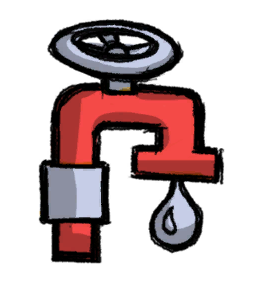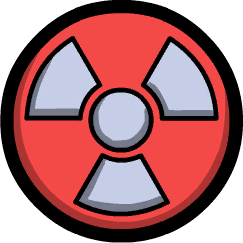Gas Reservoir
Gas Reservoir is a building that allows for 1000 kilograms of Gas storage.
It can connect to a Gas Intake Pipe and a Gas Output Pipe, and is useful as a power-free in-line buffer, since it also eliminates need for intermediary Gas Pumps. At least one segment of Gas Intake Pipe must be connected for Gas Reservoir to work. Gas Output Pipe is optional.
Be aware the Reservoir can overheat depending on the environment it is sitting in, and has a low initial overheat temperature of 75 °C. It is best to build them out of Gold Amalgam or steel when dealing with high temperature environments.
Disabling the Reservoir
Reservoir can be disabled by Duplicant, when disabled it only stops outputting its content, while still accepting the input.
This can also be achieved by destroying the base the Reservoir is built upon, which can be automated by building it on top of a Mechanized Airlock and open and closing it via automation. Only a single tile of the Reservoir must be on top of an open Mechanized Airlock for it to be disabled.
Liquid Reservoirs Versus Gas Reservoirs
Resources are best kept in the form of solids, because Storage Bins remain the most economical and compact means of storage. However, if resources cannot be feasibly kept in solid forms due to volatile thermal properties (e.g. narrow temperature ranges in between their forms), then they have to be kept in fluid form.
In this case, the Liquid Reservoir is a better choice, if the resource can be held in liquid form prior to any downstream processing. For example, if the player's intention is to hold fuel for Hydrogen Generators, it is better to keep Water in Liquid Reservoirs (for piping into Electrolyzers later) than keeping Hydrogen in Gas Reservoirs: A single Liquid Reservoir can hold 5000 kg of water which can be electrolyzed to produce 560 kg of Hydrogen, and one Liquid Reservoir occupies 6 tiles of space for a density of about 833.33 kg/tile of water, or 93.33 kg/tile of Hydrogen. In comparison, one Gas Reservoir can hold up to 1000 kg of Hydrogen, but occupies 15 tiles, giving a density of only 66.67 kg/tile.
- However, the Gas Reservoir can allow for easier pipe-laying (due to its larger footprint) than Liquid Reservoirs, especially if the Liquid Reservoirs are to be placed next to each other.
- Moreover, having a Gas Reservoir for holding the results of downstream processing, e.g. the Hydrogen from Electrolyzers and their attendant Gas Pumps, allows for considerable reserves in the case of disruptions and for easier monitoring.
Tips
- It is generally best not to expose Gas Reservoirs of any material to extreme environments. They release their contents when they are completely damaged which can be a major problem since, unlike buildings which only store solid or liquid contents, escaping gasses are not easily contained and will quickly spread far and wide.
- Contents inside the reservoir only exchange heat with two tiles: the tile containing the reservoir's output port and the tile right below the output port (i.e. the reservoir's bottom-middle tile and the tile directly below that). A reservoir's contents will not heat up or cool down the reservoir itself directly. Thus, if both of these two tiles are in a vacuum (e.g. by placing an Airflow Tile, Mesh Tile, or Insulated Tile below the output port and keeping those tiles in a vacuum), then there will be no heat exchange at all - i.e. you can store very hot or very cold gases in a Copper reservoir without them heating up or cooling down their surroundings.
- The reservoir itself will exchange heat with all 15 of its tiles, but no surrounding tiles. If the reservoir is not kept in a vacuum, then its contents will exchange heat with whatever substance occupies its bottom-middle tile (e.g. a gas or liquid), and that substance will exchange heat with the reservoir itself.
- Depending on the type of gas, a Gas Reservoir may be a significantly more space-efficient means of storing gases than leaving them in the world. For example, gas vents overpressurize at 5 kg per tile, and one Gas Reservoir holds 1000 kg - the equivalent of 200 max-pressure tiles of a vent's output, contained in a building which only occupies 15 tiles. Even if one were to pump the same 1000 kg of gas into a room at 20 kg/tile using High Pressure Gas Vents, it would require 50 tiles of space.
- However, there may still be more space-efficient ways of storing the same materials, such as in liquid or solid form. See the above comparison with Liquid Reservoirs for more details.
- Gas Reservoirs are more energy efficient and more convenient than storing gases externally, due to their inclusion of output and input ports (which can already drive fluid flow on their own). More importantly, Gas Reservoirs, like Liquid Reservoirs, do not block Duplicant access.
- If a reservoir is submerged in Chlorine, any germs on its contents will be quickly killed.
- Gas Reservoirs average out the temperature of each gas pumped into it (thus smoothing out temperature spikes/differences from the input gas). This allows, for example, for much easier temperature control if a Gas Pipe Thermo Sensor is placed on the output pipe.
- Gas Reservoirs automation outputs can be used to control filters with a NOT Gate, to ensure that the filter only operate when the tank has filled up to a certain level, and fully take advantage of the buffering capabilities of the reservoir.
- If multiple gases are stored(H2,O2,Cl,CO2 from lighter to heavier), output cycles through all stored gases, but heavier gases get slight priority and the lightest gas(Hydrogen) will remain if multiple different gases of the same amount are stored. This is probably intended and due to the output tile being at the bottom of the reservoir, hence output prioritizes heavy gases.
See also
History
- RU-284571: Introduced.
- AP-395113: Gas Reservoir and Liquid Reservoir have smart storage functionality
- AP-397125: More buildings are brought forward into Overlay space in the Gas / Liquid conduit overlay
- U51-596100: Increased Gas Reservoir storage capacity from 150kg to 1000kg. Slight adjustments to building art.













































